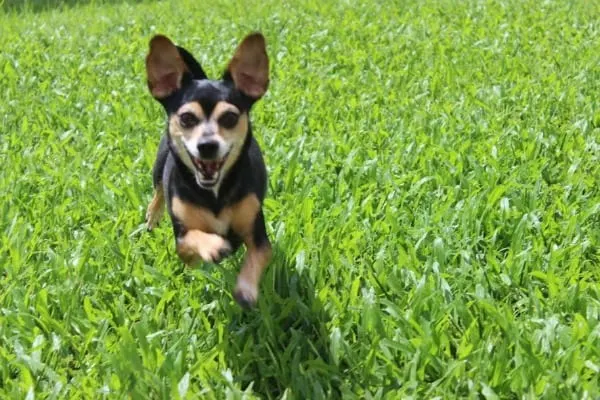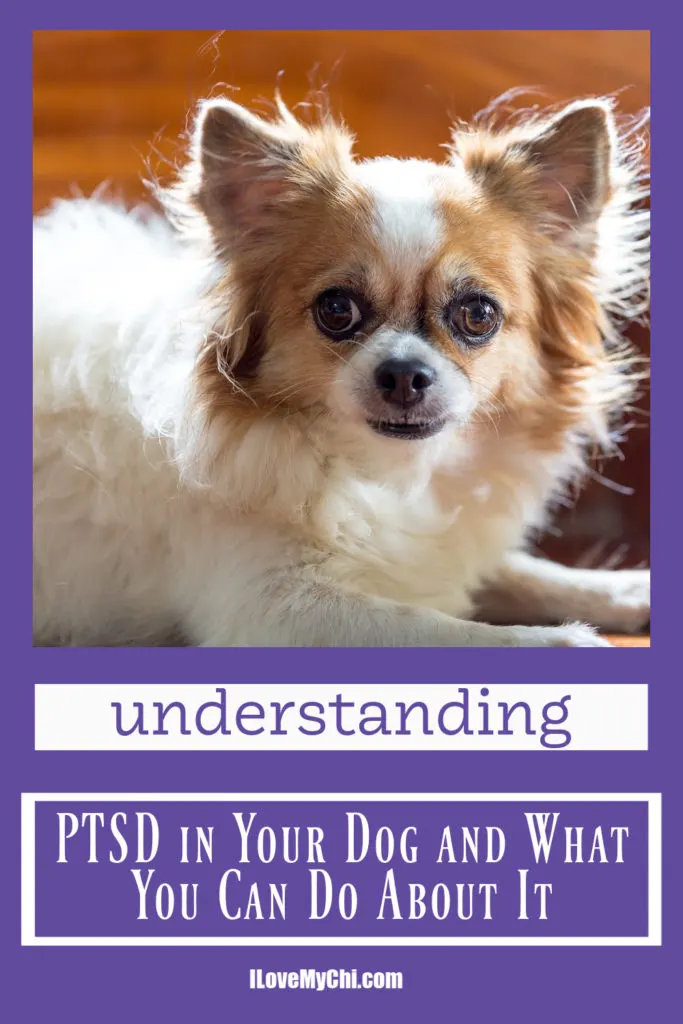Dogs can suffer from post-traumatic stress disorder (PTSD). It occurs in your canine friends very much the same way it would in humans – through traumatic experiences.
We’re talking about abuse, mistreatment, and animal cruelty, which can all contribute to PTSD in a dog. It is heartbreaking to witness your dog struggling with something as difficult as this, so we are going to take a look at what you can do to understand and help your dog.

What Does PTSD in Dogs Look Like?
How do you know if your dog has PTSD? Aside from getting a clinical diagnosis from a vet, you can monitor your pooch for certain signs.
A dog suffering from PTSD may display signs of shyness, aggression, and fear around people. He may also show signs of hypersensitivity and become clingy.
We’ll cover the symptoms in more detail below, but your dog’s behavior can be unpredictable, and it may have difficulty even with something as simple as sleeping on its own or in a home with other dogs. A dog with PTSD should undergo therapy to help them cope with their condition.
What Causes PTSD in Dogs?
In most cases, PTSD in dogs is triggered by life-threatening experiences, such as an attack or accident. However, dogs can also develop the disorder from a variety of other sources.
In one example, a dog may experience a traumatic event in which they were almost killed but was resuscitated by a veterinarian.
An example of a situation where the dog who develops PTSD did not suffer from a life-threatening experience would be abandonment.
Symptoms of PTSD in Dogs
Symptoms of PTSD in dogs are a very real concern.
First, you should understand the differences between acute and chronic post-traumatic stress disorder.
Acute reactions begin immediately after a traumatizing incident, and they usually subside after three months.
On the other hand, chronic symptoms last longer than three months.
Then there is delay-onset post-traumatic stress disorder, with symptoms that can show up more than six months after the traumatic event. When a dog goes through something difficult, it’s unfortunate that the latter is more likely to be the case, and the symptoms are often worse.

Known symptoms of PTSD in dogs:
● Excessive panting
● Anxiety
● Fearfulness
● Panic
● Clinging to owners
● Timidness
● Depression
● Uncharacteristic aggression
● Hyper-vigilance
● Sleep disturbances
● Decreased interest in favorite things, food, and activities
In addition to these signs, your dog may show aggressive behaviors and fearful behavior around other animals.
PTSD in dogs can be difficult to detect, but it definitely can be treated. A vet can prescribe an anti-depressant to help your pet cope. In some cases, natural remedies can also be helpful.
There could be other issues that present themselves as possible PTSD cases when in reality, they end up being something completely different. The best person to help you reach a surefire conclusion about whether or not your dog has PTSD is your vet.
You could mistakenly diagnose a health issue for PTSD if you’re only basing it on a few symptoms. Sometimes the cause for PTSD symptoms is not a traumatic event but something as simple as boredom or separation anxiety. Don’t jump to conclusions just yet!
What Can You Do For a Dog With PTSD?
If you think your dog may have PTSD, you should consider taking steps to help him deal with the situation. For example, you can use natural stress relievers or calming treats to calm your dog.
These techniques can help you get your dog to focus again. These techniques can also help you prevent the symptoms that can occur when your dog experiences PTSD.
Training and Therapy
Behavioral training and therapy for PTSD is another recommended course of action to take. The professional animal behaviorist may try exposing your dog to the trigger, such as loud noises in order to desensitize him.
Once your dog becomes calmer and more accepting towards the trigger, this is when you can introduce the stress reliever or calming treat so your fur baby will eventually come to associate the trigger with the good things.
You should keep in mind that treating your dog’s PTSD can be a lengthy process, and it is important to remember to come at it with a ton of patience.

Keep to a Routine
Dogs thrive on routine, and this is the same even for a mentally healthy dog.
Anything that is spontaneous and sudden can trigger anxiety in a PTSD dog. You need to let your dog know that the world is “predictable” (at least their world), and there is an order to things.
Feeding, walking, and sleeping at the same time each day will help ground your PTSD dog.
We understand that it can be tough sometimes as we can never plan for the unexpected, but remain as close as possible to the standard routine. It will take effort on your part, but your pooch will really benefit from this.
Mental and Physical Stimulation
A PTSD dog with signs of depression and a loss of interest will be a little tougher to deal with, but you still have to make sure they get their daily exercise both mentally and physically.
A dog suffering from trauma that is allowed to run and play freely will be reminded of what happiness is, and hopefully, learn to trust other humans and dogs in the process.
For mental stimulation, we suggest using a puzzle toy or doing some light training to keep your dog’s mind sharp.

How Long Does it Take for a Dog to Get Over A Trauma?
Many different factors determine how long it takes for a dog to recover from trauma. The process of decompression for a dog can take up to several weeks or even months. The best thing to do is to keep the dog happy, try your best to approach it calmly, kindly, with
soothing voices and a nurturing demeanor.
As we said, it will take time until your dog feels like they are ready to trust again, but with patience, you will get there. The right support is a primary part of your dog’s recovery process.
Managing PTSD In Dogs
Maybe your dog will have to live with some level of trauma for the rest of their life.
While we’re pretty confident that you can help your dog to live a normal life again with our tips above, some management may be required during the process. So, what can you do to help your dog manage it? Natural is the best way to go, and dog parents are becoming increasingly aware of the benefits healthier ingredients and natural remedies have over the alternative. Many holistic methods have been proven effective for both humans and canines with a variety of conditions.
A Calming Environment
A calming environment with familiar toys and clothing, as well as exercise, can help your pet overcome PTSD. A calming environment is essential for a dog experiencing PTSD. Loud sounds usually trigger a traumatic memory and scare even happy-go-lucky dogs, so a safe environment can help speed up the recovery process.
Your Love and Support
The best way to treat PTSD in dogs is to be positive and supportive of your dog.
Don’t coddle a fearful dog. Instead, try to make your dog associate the fearful situation with a positive thing, this is called positive association. Your dog may not respond immediately, but you can help him feel better.

Natural and Holistic Ingredients and Practices
There are a variety of herbs and nutraceuticals that can help dogs with PTSD. A melatonin supplement is safe for most dogs but check with your vet to be sure. In fact, you should consult with your vet before introducing anything new to your dog’s diet.
There are other supplements that are available for dogs that are made specifically for calming and PTSD purposes. Acupuncture is a proven way to treat PTSD in canines. Acupuncture is a practice in traditional Chinese medicine and is considered a form of alternative medicine in the west. It is a procedure that involves needles inserted into pressure points. For humans, it can treat pain, stress, and be used for overall wellness. Now the practice can be extended to dogs to help with stress management.
Sometimes something as simple as a weighted blanket can assure your dog and give it some comfort when it starts to feel anxious. Weighted blankets are available in most major pet stores. While you’re there, you can also look into calming scents such as lavender, which are available for purchase with diffusers.
It’s amazing how closely related the treatment plan for trauma is for humans and dogs. There are many ways to help your dog deal with PTSD, but make sure your dog is comfortable with the treatment plan. For example, acupuncture involves needles, and we can totally understand why a dog may not be too happy with this particular form of treatment. Don’t force your dog into doing something he doesn’t want to do as it can exacerbate the trauma.
ALSO READ:
What Your Dog’s Body Language And Sounds Are Trying To Tell You


Susie
Monday 21st of March 2022
Lucy and all your dogs Kathy are so adorable. Thank you for sharing there pictures with us.
Cathy
Tuesday 22nd of March 2022
Thank you Susie and I'm glad you like the pics!